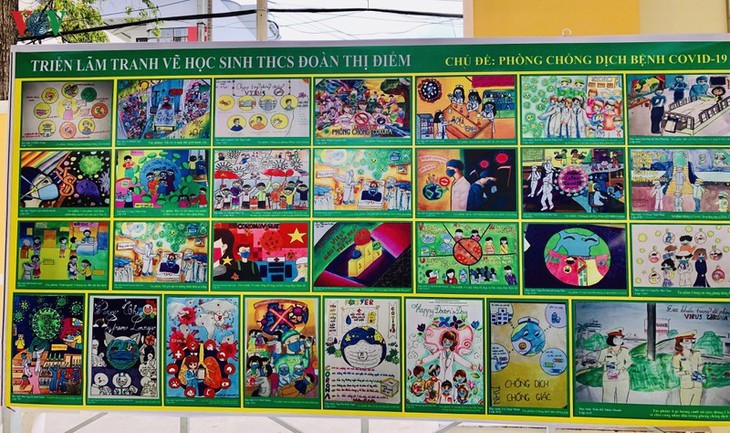 Students of Can Tho university draw paintings to encourage people in the fight against COVID-19 Students of Can Tho university draw paintings to encourage people in the fight against COVID-19 |
B: We’d like to acknowledge feedback from Abu Sayed of Bangladesh. Mr. Abu Sayed listened to our program from 16:06 to 16:26 on April 7 on the frequency of 7720 khz. He wrote: “After several years I listened to your radio program through shortwave again and sent a reception report. Due to the availability of the Internet, I always listen to your program online for several years. But listening to a shortwave radio has a different taste.”
A: Thank you, Mr. Abu Sayed, for your reception report on our shortwave broadcasts. We’ll send you a QSL card to confirm it but just to remind you that your comments on our online content are always welcomed. We hope to receive more feedback from our dear listeners.
B: This week, we received an email from Juan Sebastian Blas Rio of Argentina but he sent a reception report for a VOV program in Vietnamese on the frequency of 7435 khz. Mr. Juan Sebastian Blas Rio, we will forward your reception report to the overseas Vietnamese section which produces programs in Vietnamese for overseas Vietnamese people around the world.
A: We hope to receive your feedback on our English program and will send you our frequency list and program schedule. You can also check out our English program on the internet at vovworld.vn or on mobile app called “VOV Media”, where you can listen to our program in 13 languages including English, Vietnamese, French, German, Spanish, Japanese, Russian, Chinese, Korean, Lao, Thai, Cambodian, and Indonesian.
A: We’d like to remind you that the Voice of Vietnam has launched the “What do you know about Vietnam?” contest, which is held every 5 years. The 2020 contest, which coincides with many important events in Vietnam and VOV, is open to foreigners and overseas Vietnamese around the world.
B: We have posted 6 questions and requirements to participate in the contest on our website at vovworld.vn. You can find them in our Letter Box segments or in the “About Us” segment on the website.
A: By listening to our programs regularly and reading stories on our website, you can easily find the answers to these questions. In addition, if you share with us your stories about Vietnam and your impression on the Voice of Vietnam, you will receive extra scores for your entries.
B: The contestants who submit the 3 best entries will win a free 5-day trip to Vietnam. Good luck to you all!
A: We hope that listeners of the English program will win the contest and a trip to Vietnam. We hope to meet you in Vietnam when the epidemic is over.
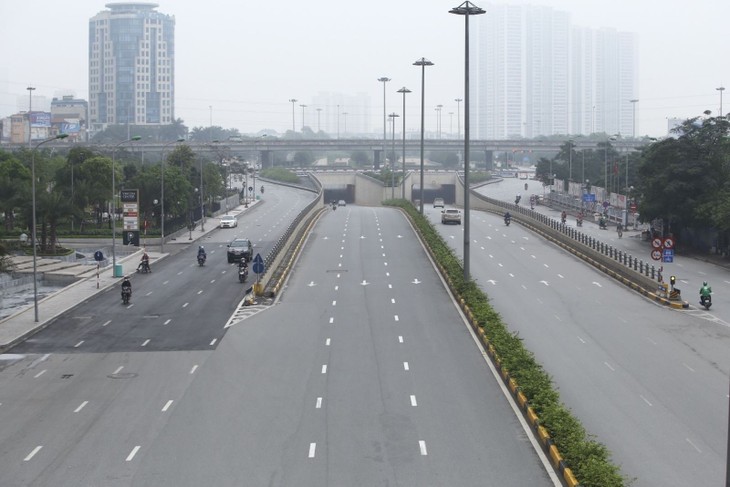 Streets in Hanoi during the period of social distancing due to Covid-19 Streets in Hanoi during the period of social distancing due to Covid-19 |
B: This week, we received less letters and emails from our listeners and we blamed it on the epidemic. As of Wednesday morning, 251 Covid-19 infections have been confirmed in the country and 122 of them have already recovered.
A: In many emails we received, listeners asked about things happening in Vietnam during the Covid-19 epidemic.
A: Social distancing and working from home are being practiced in Vietnam and many other countries around the world as a way reduce risks of infection and transmission of the deadly virus.
B: Life still goes on while around 4 billion people around the world are staying at home. Let’s have a look at what Google found about social distancing in Vietnam.
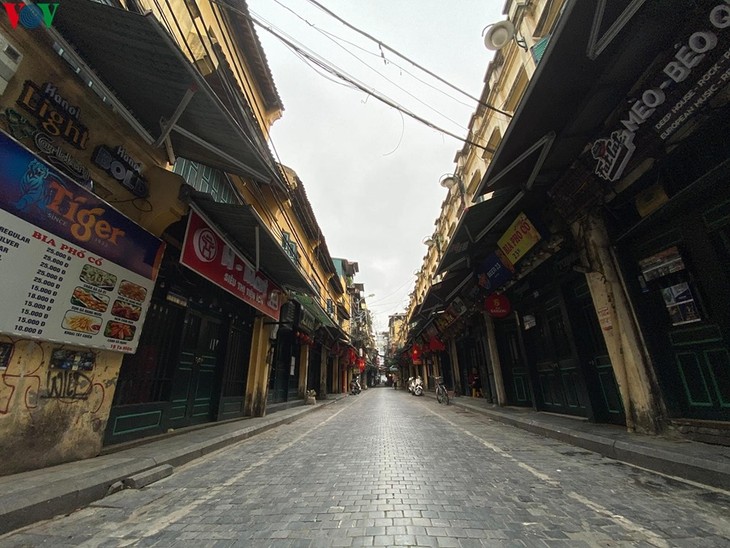 Hanoi's Old Quarter during social distancing days due to the coronavirus epidemic Hanoi's Old Quarter during social distancing days due to the coronavirus epidemic |
A: Topics related to social distancing and news from the Health Ministry are top articles that interest Vietnamese internet users amid the Covid-19 pandemic.
B: "Social distancing" and related topics started to gain more popularity last month, when Vietnam confirmed the 17th Covid-19 patient on March 6 after going 22 days without new infections.
A: Notably, the number of Vietnamese googling these keywords skyrocketed on March 31, a day before a nationwide social distancing campaign was implemented, Google said Friday.
B: The social distancing campaign also sparked an increase in searches related to delivery services, online shopping and online learning.
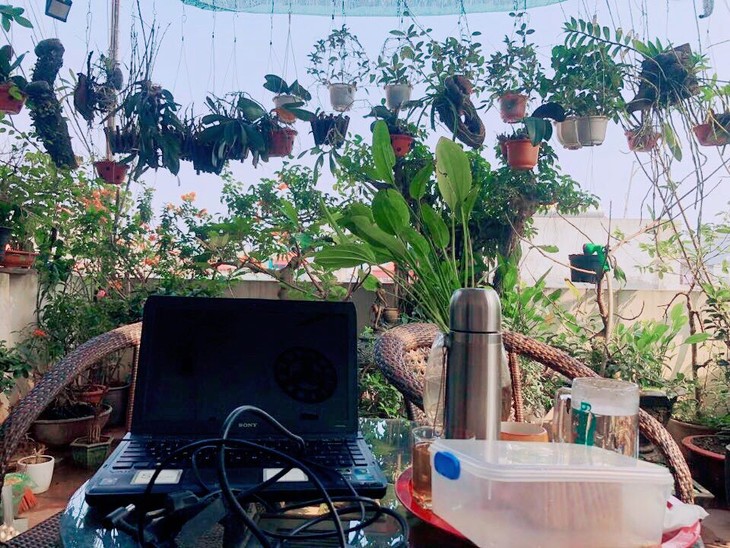 Due to social distancing, many people have to work home Due to social distancing, many people have to work home |
A: With many working from home and all eateries closed, the search tool was also deployed by many for information on electric devices and home appliances such as printers, computers, air fryers and cookers.
A: That’s what Google found about social distancing in Vietnam. Here at VOV, we found that many listeners are interested to know what Vietnamese people are doing these days when practicing social distancing during the epidemic.
A: As we have shared in our recent programs, these days, not only people in Vietnam but also around the world have begun to do many new things that they have never done before trying to make their time at home and more fun.
B: One of the things we do is cooking and sharing our cooking recipes. Today, we’d like to share with you a recipe to make spring rolls or nem, one of Vietnam’s most popular dishes at home and overseas.
A: Today we are not talking about deep fried spring rolls that you often think of when talking about Vietnamese spring roll but we will share with you a recipe to make “Pho cuon” - fresh rice paper rolls with stir fried beef and herbs.
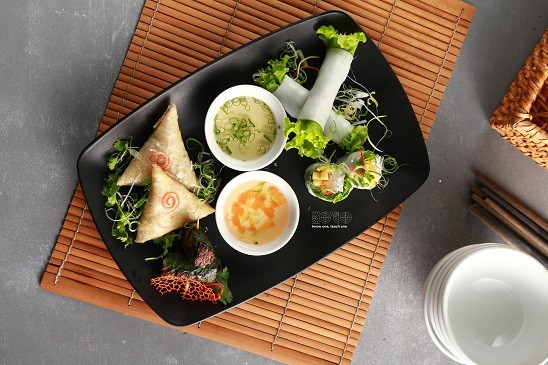 “Pho cuon” - Fresh rice paper rolls with stir fried beef and herbs “Pho cuon” - Fresh rice paper rolls with stir fried beef and herbs |
B: It’s not difficult to make and we hope that you can cook Vietnamese food at home when you are lazing around with your children. It’s easy because you can find ingredients to make this dish in your kitchen or in a nearby store.
A: We need rice paper, beef and a variety of herbs like coriander, spearmint, and lettuce. Lettuce is important to put in spring rolls because when you put lettuce inside, the lettuce covers the filling and the rice paper won’t break when you roll it. Another ingredient is carrot. Carrot is very crunchy. The last ingredient we should put in the spring roll is shallot. You can fry the shallot.
B: First, we need to marinate the beef with the garlic, oil, pepper, and oyster sauce. After that, stir fry it with sliced onion. When you are nearly finished stir frying the beef, add the bean spouts.
A: We just take one sheet of fresh rice paper, put some lettuce on the rice paper, but remember the lettuce should be spread to cover the rice paper to ensure the fillings will not drop out and break the rice paper when we roll it.
B: Add the fillings with coriander and spearmint leaves, put the carrot in the middle for color. Just sprinkle the shallot on the top. We finish with the beef on the top, then roll it tight. If it’s not tight, when you cut it, the filling will fall out.
A: Then we make a dipping sauce with 3 spoons of sugar, and two and a half spoons of rice vinegar, a half spoons of fish sauce and finish with garlic and chilli but the garlic and chilli need to be finely chopped. Cut the spring rolls in half and put them on a plate. Put the dipping sauce in a small bowl and place it on the plate. And now Vietnamese fresh spring rolls are ready. Enjoy!
A: We’re looking forward to hearing your stories about things happening in your countries during the epidemic, what people do and how your country manages to cope with the disease.
A: Thank you all for your reports and feedback on the program content and technical reception. They are extremely helpful for us to improve our transmission. We’ll send you QSL cards to confirm.
A: We welcome your feedback at: English Service, VOVworld, the Voice of Vietnam, 45 Ba Trieu street, Hanoi, Vietnam. Or you can email us at our new email address: englishsection@vov.vn. You’re invited to visit us online at vovworld.vn, where you can hear both live and recorded programs.
B: Check out our VOV Media App, available on both the IOS and Android platform to hear our live broadcasts. We look forward to your feedback on the mobile version of vovworld.vn. Once again, thank you all for listening.